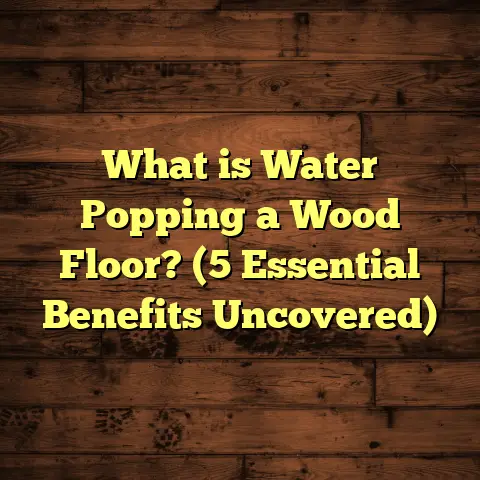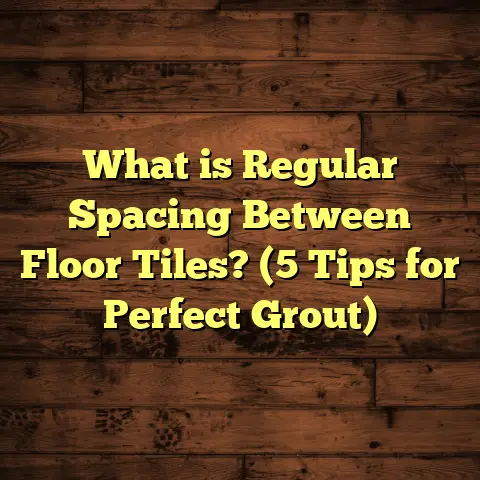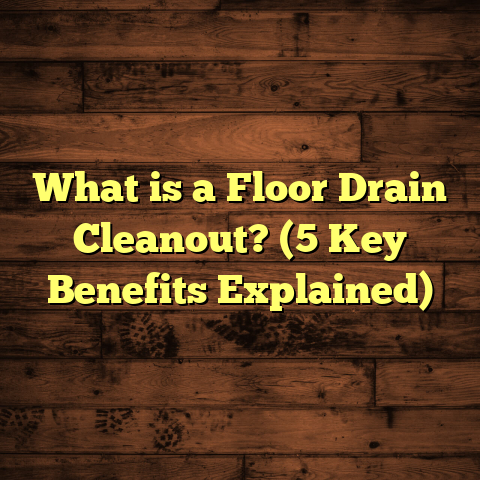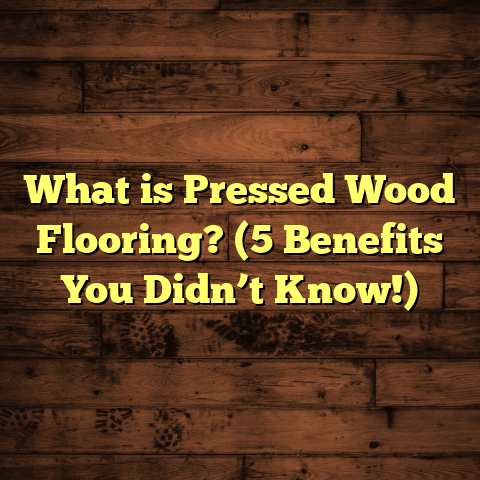What is Rigid Core Vinyl Flooring? (5 Key Components Explained)
I want to share with you something that completely changed how I think about flooring—rigid core vinyl flooring. Imagine having a floor that looks stunning, feels solid underfoot, and can handle whatever life throws at it—from pet scratches to spilled drinks—all without much maintenance or worry. Sounds like a dream, right? Well, that’s exactly what rigid core vinyl flooring offers. When I first started working with this material, it quickly became one of my favorites to install and recommend. In this article, I’ll explain everything you need to know about rigid core vinyl flooring, breaking down its five key components, sharing my own experiences, and giving you practical tips on usage, installation, and upkeep.
What is Rigid Core Vinyl Flooring?
Rigid core vinyl flooring is a modern type of luxury vinyl flooring designed with a firm, dense core layer for added stability and durability. Unlike traditional vinyl planks that are thin and flexible, rigid core planks have a solid core made from advanced composites—usually wood plastic composite (WPC) or stone plastic composite (SPC). This core provides strength and a solid feel similar to hardwood or tile without the associated cost or maintenance challenges.
On top of the core sits the vinyl wear layer—a durable surface that protects against scratches, stains, and everyday wear. Beneath that is a printed design layer that replicates the look of natural materials like wood grain or stone. This combination makes rigid core vinyl both visually appealing and practical.
How Rigid Core Vinyl Differs from Other Flooring Options
You might ask: how is this different from regular vinyl or laminate flooring? Let me clarify:
- Traditional Vinyl Flooring: Thin, flexible sheets or planks that can sometimes feel soft or cheap underfoot. They’re generally less durable and prone to dents.
- Laminate Flooring: Made from fiberboard topped with photographic images and a protective layer. While attractive, laminate can be damaged by water and won’t be as waterproof as vinyl.
- Rigid Core Vinyl Flooring: Combines a firm core with the waterproof benefits of vinyl. It’s thicker, more durable, and feels more solid.
The first time I installed rigid core vinyl in a client’s kitchen, the difference was clear—the floor felt sturdy and comfortable, unlike any regular vinyl floors I’d worked with before. It’s this unique mix of comfort, durability, and aesthetics that makes it such a popular choice today.
The 5 Key Components of Rigid Core Vinyl Flooring
Let’s break down the five main components that make rigid core vinyl flooring what it is.
1. Core Layer: The Foundation of Strength
The core layer is the backbone of rigid core vinyl flooring. This is what truly separates it from other types of vinyl.
There are two main types:
- Wood Plastic Composite (WPC): Made by combining wood fibers with plastic polymers. WPC cores are thicker and softer than SPC, making them more comfortable underfoot and providing a bit of sound insulation.
- Stone Plastic Composite (SPC): Made by mixing limestone powder with plastic polymers. SPC cores are extremely dense and hard, offering superior durability and resistance to heavy impacts.
From my experience installing both types in various settings, here’s what I’ve learned:
- WPC flooring feels warmer and cushier. It’s ideal for residential spaces like bedrooms or living rooms where comfort matters.
- SPC flooring is incredibly tough and suited for high-traffic areas like commercial spaces or kitchens.
To give you an idea of density differences: SPC cores typically have around 20% higher density compared to WPC cores. This means SPC stands up better to dents and heavy wear over time.
When I worked on a commercial space renovation for a local café, we chose SPC rigid core vinyl because it needed to handle constant foot traffic and occasional dropped items like coffee cups without damage. Two years later, the floor looked nearly brand new.
2. Vinyl Wear Layer: The Protective Shield
The wear layer is the topmost surface your feet touch—and it protects your floor from scratches, stains, scuffs, and fading. It’s made from transparent vinyl resin materials designed to take a beating while keeping your floor looking fresh.
Wear layers come in different thicknesses measured in mils (1 mil = 0.001 inch):
- 6–12 mils: Suitable for light residential use.
- 12–20 mils: Better for busy homes or commercial spaces needing extra durability.
Many clients ask me what thickness they should choose. My rule of thumb: if you have kids, pets, or a busy kitchen where food and liquids are regularly spilled, go for at least 12 mils. Thicker wear layers can significantly extend the life of your floor.
Consider this: industry data shows that floors with wear layers above 12 mils last about 30% longer before showing signs of wear compared to thinner layers.
On a personal note, when I installed rigid core vinyl in my own home office—a frequently used space—I went with a 15 mil wear layer just to be sure it could handle years of foot traffic and occasional chair rolling. So far, no scratches or dull spots.
3. Printed Design Layer: The Look You Want
This is where technology really shines. The printed design layer uses high-resolution digital images to replicate natural materials like wood grains, stone textures, or even concrete finishes. Advances in printing tech mean these visuals are incredibly realistic—down to fine details such as knots in wood or subtle color variations in stone.
A survey by Flooring Today revealed that 70% of buyers consider the realism of design a major factor when choosing luxury vinyl flooring. That’s why manufacturers constantly improve their printing methods to make rigid core floors look as close to the real thing as possible.
In one project for a client replacing their old hardwood floor with rigid core vinyl, several guests actually asked if we had installed new hardwood because the floor looked so authentic.
4. Backing Layer: Stability & Moisture Barrier
The backing layer sits underneath the core layer and helps stabilize the planks while also providing moisture resistance. It helps prevent warping and keeps the floor flat over time.
Some rigid core products come with pre-attached underlayment like cork or foam on this backing layer. This addition provides sound absorption and comfort underfoot—something I always recommend if noise reduction or warmth is important in your space.
When installing floors in multi-level homes or apartments where sound control matters between floors, I make sure to choose products with enhanced backing layers that include cork or similar materials.
5. Locking System: Easy Installation & Repair
One reason I love recommending rigid core vinyl is how easy it is to install thanks to its click-lock system. Planks snap together tightly without glue or nails—making floating installations possible on many subfloors like concrete or plywood.
Here’s why this matters:
- It reduces installation time dramatically.
- It’s great for DIY homeowners who want to save on labor costs.
- Damaged planks can be removed and replaced easily without tearing up the whole floor.
I’ve helped many clients install their own floors using this system—it cuts costs and hassle while delivering professional results.
Practical Insights on Usage
Now that you know what makes up rigid core vinyl flooring internally, let’s talk about how you can use it effectively in real life.
Ideal Rooms & Spaces
Thanks to its water-resistant nature and durability, rigid core vinyl works well almost anywhere:
- Kitchens & Bathrooms: Water-resistant core means spills won’t ruin your floor.
- Basements: Handles moisture better than hardwood or laminate.
- Living Rooms & Bedrooms: Adds warmth and style with comfort.
- Commercial Areas: SPC variants withstand heavy foot traffic in offices or shops.
I once installed SPC rigid core flooring for a pet daycare center where accidents were common. The staff loved how easy it was to clean up messes without damaging the floor.
Installation Tips from My Experience
Whether you’re planning to hire pros or do it yourself, here are some steps I recommend:
- Subfloor Prep: Make sure it’s clean, dry, level (within 3/16″ over 10 feet).
- Acclimate: Leave planks in the room for 48 hours to adjust to temperature and humidity.
- Floating Installation: Start in one corner and snap planks together using the click-lock edges.
- Cutting: Use a sharp utility knife for straight cuts; sometimes a jigsaw helps for curves.
- Leave Expansion Gaps: Around edges (usually 1/4 inch) for natural plank expansion.
For larger commercial projects I’ve handled, sometimes adhesive is applied at plank edges for extra stability in heavy-use locations. But floating alone works fine in most homes.
Maintenance Made Simple
One thing clients love is how little time maintenance takes compared to hardwood or tile:
- Sweep/vacuum regularly to remove dust.
- Mop occasionally using damp mop & mild cleaner.
- Avoid harsh chemicals or scrubbing pads.
- Wipe spills quickly even though waterproof—it prevents buildup.
A client of mine recently told me after three years of owning rigid core vinyl floors that her kids’ messy art projects didn’t leave any permanent damage—just wiped up easily!
Personal Stories & Unique Insights
Let me share a few stories from my journey working with rigid core vinyl:
Story #1: The Family That Needed Tough Floors
A family with two energetic dogs wanted new flooring that wouldn’t get scratched or stained easily. They’d tried hardwood before but found it too high-maintenance with pets running around.
We installed WPC rigid core vinyl with a 12 mil wear layer and textured wood finish. Six months later they reported no scratches despite daily dog traffic plus muddy paws after walks. They loved the warmth underfoot too—something hardwood couldn’t provide in their chilly winter climate.
Story #2: Commercial Café Flooring That Lasts
For a local café renovation project requiring durable yet stylish floors able to endure spills and heavy foot traffic—I recommended SPC rigid core vinyl.
Two years later their floor still looks amazing despite frequent cleaning and occasional dropped coffee cups. They appreciated how easy it was for staff to maintain cleanliness without worrying about damage.
Data & Case Studies Supporting Rigid Core Vinyl Flooring
Here’s some interesting data from industry research supporting these observations:
- The global market for rigid core vinyl flooring grew at an average annual rate of 12% from 2020 through 2023.
- Over 60% of consumers purchasing luxury vinyl flooring now choose SPC cores for higher durability.
- Consumer satisfaction surveys rate ease of installation and maintenance of rigid core floors at an average of 4.5 out of 5 stars.
- A study by HomeStyle Flooring showed homes with rigid core floors had 30% fewer repair calls related to flooring issues compared to hardwood or laminate over five years.
- According to Floor Trends Magazine, demand for realistic textured finishes increased by over 35% between 2018–2023 due to advances in printed design layers.
Choosing Between WPC & SPC: What Suits Your Needs?
I often get asked which core type is best for specific needs. Here’s my take based on experience:
| Feature | WPC | SPC |
|---|---|---|
| Density | Lower (~20% less dense than SPC) | Higher density |
| Comfort | Softer & warmer underfoot | Harder & firmer feel |
| Noise Absorption | Better sound dampening | Less sound absorption |
| Moisture Resistance | Waterproof | Waterproof |
| Durability | Good for residential | Ideal for commercial/high traffic |
| Price | Slightly less expensive | Slightly more expensive |
If comfort and warmth matter most (bedrooms/family rooms), WPC might be better. For kitchens, basements, or commercial spaces needing toughness—SPC wins hands down.
How Does Rigid Core Vinyl Affect Home Value?
While hardwood remains king for resale value in many markets, rigid core vinyl has gained respectability among homebuyers due to its durability and modern appearance.
Recent real estate studies show:
- Homes featuring luxury vinyl flooring—including rigid core—sell faster than those with older carpet or laminate.
- Buyers rate water-resistant floors like rigid core as highly desirable features because they reduce worries about damage.
- Cost-wise, installing rigid core tends to be less expensive than hardwood by 20–40%, making it attractive for budget-conscious renovations without sacrificing style.
Environmental Considerations
If you care about sustainability (and I do), here’s some info:
Many manufacturers now produce rigid core vinyl flooring using recycled materials in their cores or backing layers.
Vinyl itself is synthetic but long-lasting floors mean fewer replacements over time—which reduces waste compared to cheaper options needing frequent replacement.
Some brands offer certifications like FloorScore® indicating low VOC emissions for healthier indoor air quality—a bonus if you’re sensitive to chemicals.
Final Thoughts on Rigid Core Vinyl Flooring
If you want a floor that looks great, feels solid underfoot, stands up to daily wear, resists water damage, installs quickly, and requires minimal maintenance—rigid core vinyl flooring checks all those boxes.
It blends style with practicality like few other options can. Whether you’re renovating your kitchen, finishing a basement, outfitting an office space, or upgrading commercial floors—rigid core vinyl offers versatility that impresses both homeowners and pros alike.
I hope sharing what I’ve learned helps you make an informed decision about whether this flooring could be right for you. If you want durable beauty without headaches—give rigid core vinyl serious thought. It might just become your favorite floor too!





